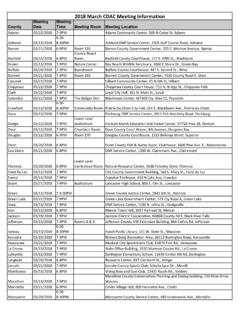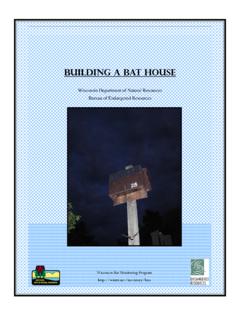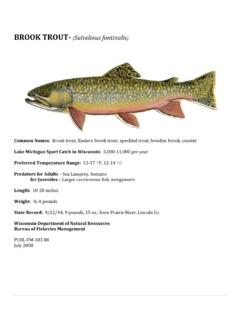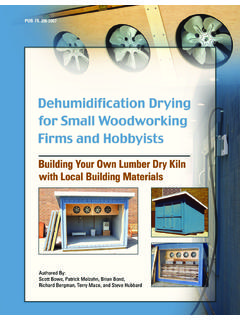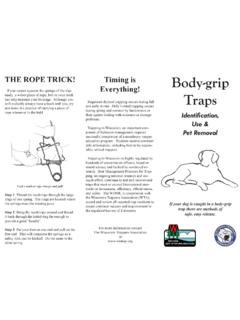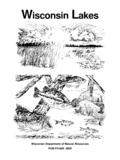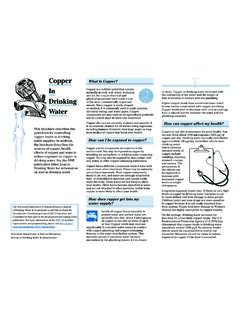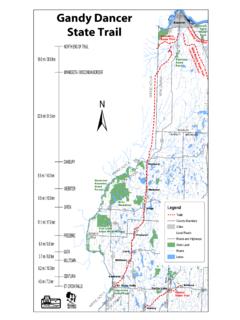Transcription of ANALYTICAL DETECTION LIMIT GUIDANCE & Laboratory …
1 ANALYTICAL DETECTION LIMIT GUIDANCE & Laboratory Guide for Determining Method DETECTION LimitsWisconsin Department of Natural ResourcesLaboratory Certification ProgramApril 1996 PUBL-TS-056-96introduction and backgroundThe Department of Natural Resources (DNR) form ed a Technical Advisory Committee in November, 1990 atthe request of the Secretary of the Department to exam ine the LOD/LOQ language in Ch. NR 106, Wis. , and the corresponding language in WPDES perm its to determ ine if the perm it language was consistentwith the code, and if not, to form ulate recommendations to achieve consistency. The committee's report (WIDNR, 1994), issued on January 2, 1994, recommended implementing new, consistent perm it language basedupon scientific limitations. The report also addressed related LOD/LOQ issues facing the Department raisedthrough the investigation but not directly within the Committee's charge.
2 These issues were deemed criticallyrelated to the LOD/LOQ issue and the Committee urged the Department "to give serious consideration toimplementing (these) recommendations". Among them: Department needs to provide perm ittees with GUIDANCE instructing them how to report, interpretand apply sam pling results that are below the Department needs to develop uniform definitions of LOD and LOQ which are applicable to allenvironmental sam pling program need for consistent definitions and low level data reporting across all of the agency's environmentalprogram s compelled the Laboratory Certification Program , to play a significant role in coordinating theDepartment's efforts. The Laboratory Certification Code, Ch. NR 149, Wis. Adm. Code, which requireslaboratories to statistically determ ine their DETECTION limits , was revised to address the Committees'recommendations.
3 An am endment requiring laboratories to report ANALYTICAL data for selected substances downto their calculated DETECTION LIMIT becomes effective January 1, 1997. This requirement was created tosupplement other Administrative Codes, many of which already require facilities and site owners to reportanalytical data down to a calculated DETECTION LIMIT . This rule change also modified the definitions of the limitof DETECTION and LIMIT of quantitation for consistency with Chs. NR 106, NR 140, proposed NR 507, and NR809. Wis. Adm. the present time, the Department requires certified and registered laboratories to calculate DETECTION limitsusing the Environmental Protection Agency Method DETECTION LIMIT (MDL) procedure found in Title 40 Code of Federal Regulations Part 136 (40 CFR 136, Appendix B, revision ). This method has both criticsand supporters. Despite its limitations, it remains the most widely documented and one of the simplest waysto calculate a DETECTION LIMIT .
4 However, the procedure is often misunderstood, and invalid MDLdeterm inations are common. The Department conducted an interlaboratory survey of semivolatile organiccompounds DETECTION limits in April of 1993. Of the 56 labs surveyed, 23 incorrectly calculated their MDLs. The Laboratory Certification Program developed this GUIDANCE to assist laboratories follow the procedurecorrectly and generate meaningful DETECTION limits . These meaningful DETECTION limits are a critical first steptoward meeting the agency's data needs of the future, where toxicology is expected to continue to push theboundaries of ANALYTICAL document interprets the Laboratory Certification Program 's policy on limits of DETECTION , and containshelpful hints and suggestions to assist laboratories calculate method DETECTION limits . It provides alternativesfor ANALYTICAL methods which do not lend themselves well to statistical DETECTION LIMIT determ , this document provides GUIDANCE for perform ing a "common sense check" on a calculated MDL.
5 This document supplements the Code of Federal Regulations procedure for calculating the method detectionlimit. In all cases, the Federal Regulations protocol must be followed for calculating MDLs. This GUIDANCE was written and edited by Jeffrey Ripp, a chemist in the Wisconsin Department of Natural Resources' Laboratory Certification Program. Additional copies may be requested by writing to the Laboratory CertificationProgram, Wisconsin Department of Natural Resources, 101 S. Webster St., Box 7921, Madison, WI 53707. Or, visit theWisconsin DNR online at { }.iiTable of ContentsPart I. Definitions .. 1 Part II. Method DETECTION What are Method DETECTION limits (MDLs)?.. Why do we need MDLs?.. Discussion of the MDLs' 5 Part III. Calculating Method DETECTION Practical Considerations for Improving the MDL ANALYTICAL Systems.
6 Calibrating for the MDL Choosing the Proper Spike Replicate Sample Preparation .. Analyzing Blanks .. Accounting for Day to Day Calculations .. Frequency of MDL Determinations .. Calculating MDLs for Multiple Instruments and The 50% The F-Ratio Test .. The Upper Critical LIMIT Screening Instruments .. Safe Drinking Water Instruments .. Examples of Multiple Instruments .. 11 Part IV. Validating MDL Determinations .. Common Sense The Five Point Check .. Meeting Requirements .. The S/N Test .. Percent Serial Dilutions .. Iterative 14 Part V. Examples and Special Cases .. Ammonia by Ion Selective Electrode (ISE).. Atrazine by Gas Chromatography .. Lead in Drinking Water by Graphite Furnace (GFAA).. Gasoline Range Organics (GRO) by the Wisconsin Method.
7 Common Wastewater Tests and Exempt Analytes .. Calculating Residual Chlorine DETECTION Solids (Gravimetric).. BOD and CBOD .. Titrimetric MDLs for Organic Analytes and Common Lab MDLs for High Precision 20 Part VI. Data Reporting Department Consistency NR 106 - Surface Water (Wastewater).. NR 140 - NR 149 - Laboratory NR 507 - Landfills (Proposed).. NR 720 - NR 809 - Drinking 23 Part VII. References .. 24 Appendix A: 40 CFR 136, EPA MDL IAppendix B: Procedure for Determining IVAppendix C: Sample MDL Spreadsheet .. Vivpart i. definitionsAn enormous variety of definitions relating to DETECTION limits and quantitation limits are used in theliterature and by government agencies. Unfortunately, universally accepted procedures for calculatingthese limits do not exist.
8 This can be frustrating and confusing for both regulators and the regulatedcommunity. The definitions below are not an attempt to resolve all of the confusion, but rather, anattempt to clarify the meaning of these terms as used by the Department. These definitions areconsistent with the definitions found in the Wisconsin Administrative Codes. Accuracy is a combination of the bias and precision of an ANALYTICAL procedure, which reflects thecloseness of a measured value to a true value. (Standard methods , 18th edition) For the purposes oflaboratory certification, accuracy means the closeness of a measured value to its generally acceptedvalue or its value based upon an accepted reference standard. (NR (2))Bias provides a measure of systematic, or determinative error in an ANALYTICAL method.
9 Bias isdetermined by assessing the percent recovery of spiked samples. Historically, the term accuracy hasbeen used interchangeably with bias, although many sources make a distinction between the two. (Standard methods , 18th edition) Enforcement Standard (ES) means a numerical value expressing the maximum concentration of asubstance in groundwater which is adopted under s. , Stats., and s. NR or s. ,Stats., and s. NR These standards are toxicologically derived to protect human values above the ES trigger the procedure prescribed in s. NR (s. NR (7))False Positive, or Type I (alpha) error, means concluding that a substance is present when it truly Negative, or Type II (beta) error, means concluding that a substance is not present when ittruly DETECTION LIMIT (IDL) is the concentration equivalent to a signal, due to the analyte ofinterest, which is the smallest signal that can be distinguished from background noise by a particularinstrument.
10 The IDL should always be below the method DETECTION LIMIT , and is not used forcompliance data reporting, but may be used for statistical data analysis and comparing the attributesof different instruments. The IDL is similar to the "critical level" and "criterion of DETECTION " asdefined in the literature. (Standard methods , 18th edition) LIMIT of DETECTION (LOD) or DETECTION LIMIT , is the lowest concentration level that can bedetermined to be statistically different from a blank (99% confidence). The LOD is typicallydetermined to be in the region where the signal to noise ratio is greater than 5. limits of detectionare matrix, method, and analyte specific. (ss. NR (12) & (15)) Note: For the purposes of Laboratory certification, the LOD is approximately equal to the MDL forthose tests which the MDL can be of Quantitation (LOQ), or lower LIMIT of quantitation (LOQ), is the level above whichquantitative results may be obtained with a specified degree of confidence.

